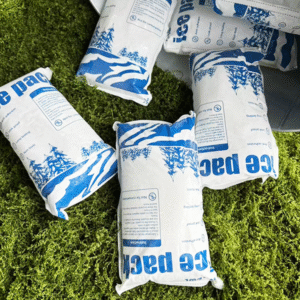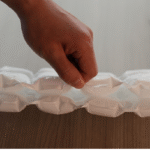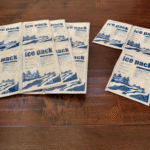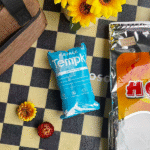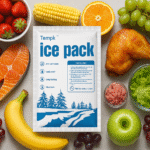Pequeñas bolsas de hielo seco están transformando la forma en que los productos congelados y ultrafríos se mueven a través de la cadena de suministro. hielo seco, o dióxido de carbono sólido, se mantiene aproximadamente a –78,5 °C (–109,3 °F) y se sublima directamente en gas. Porque no hay fase líquida., El hielo seco no empapa los envases ni los alimentos.. Estas propiedades lo hacen ideal para transportar vacunas., mariscos, helados y otros productos perecederos. Cuando se empaqueta en formato compacto, ladrillos uniformes, una pequeña bolsa de hielo seco reduce el espacio muerto y el peso al tiempo que proporciona una refrigeración constante. En esta guía aprenderá cómo funcionan estas mochilas miniaturizadas., cómo dimensionarlos para su envío, reglas de cumplimiento, consejos de seguridad, y las últimas tendencias en cadena de frío de 2025. Al final, sabrás si un pequeña bolsa de hielo seco es la elección correcta para su próximo envío.
¿Por qué las pequeñas bolsas de hielo seco proporcionan uniformidad?, Temperaturas ultrafrías sin problemas para alimentos y productos farmacéuticos.
Cómo calcular la cantidad de pequeñas bolsas de hielo seco necesarias para diferentes cargas útiles y tiempos de tránsito.
¿Qué regulaciones y medidas de seguridad se aplican al envío de pequeñas bolsas de hielo seco?.
Comparación del costo de las bolsas de hielo seco pequeñas con las de gel o el hielo tradicional, longevidad y control de temperatura.
lo último 2025 Tendencias que impulsan la innovación en el diseño y la sostenibilidad de pequeñas bolsas de hielo seco..
¿Por qué elegir una pequeña bolsa de hielo seco para el envío en cadena de frío??
Las pequeñas bolsas de hielo seco son ladrillos compactos o láminas de hielo seco diseñadas para caber cómodamente dentro de cajas aisladas.. A diferencia de los pellets que ruedan o los bloques grandes que dejan espacio sin utilizar, Estos paquetes abrazan las paredes o la tapa de un contenedor.. Porque el hielo seco se sublima directamente de sólido a gas, no deja residuos líquidos. Esto significa que sus productos permanecen secos y el embalaje no se debilita con el agua derretida..
Beneficios del hielo seco: Enfriamiento sin desorden
El hielo seco es dióxido de carbono sólido. cuando se calienta, pasa por alto la fase líquida y se convierte en gas a –78,5 °C. Esta sublimación proporciona temperaturas ultrafrías constantes y elimina el riesgo de que los paquetes se empapen o se quemen en el congelador.. La ausencia de agua también previene el crecimiento de moho y la proliferación bacteriana que puede ocurrir con el hielo derretido..
Sin residuo: La sublimación evita charcos de agua: perfecta para proteger cajas de cartón y etiquetas.
Menor peso: El hielo seco es más ligero que el agua congelada.; esto reduce el peso y los costos de envío.
Período de enfriamiento más largo: El hielo seco permanece frío por más tiempo que las bolsas de gel, haciéndolo ideal para tránsito de varios días.
Eficiencia espacial y refrigeración uniforme
Las pequeñas bolsas de hielo seco suelen ser ladrillos o láminas delgadas.. Su forma les permite forrar los laterales., parte superior o inferior de un contenedor de envío. Este diseño minimiza el “espacio muerto,“Lo que significa que hay menos aire para enfriar y una transferencia de energía más eficiente.. El resultado es una distribución uniforme de la temperatura., Reducir los puntos calientes que podrían comprometer la calidad del producto.. Para mariscos congelados o vacunas, La temperatura constante es fundamental para evitar el deterioro..
Rango de temperatura ideal
Una pequeña bolsa de hielo seco mantiene temperaturas por debajo de –40 °C, que es necesario para productos como el helado, carne y biológicos. Destaca cuando los envíos deben permanecer profundamente congelados durante más de un día.. En contraste, Los paquetes de gel generalmente mantienen los productos entre 2 °C y 7 °C. Para envíos que solo necesitan refrigeración, los paquetes de gel pueden ser suficientes; pero para envíos congelados o ultrafríos, El hielo seco es la elección superior.
Peso de embalaje reducido
El uso de pequeñas bolsas de hielo seco significa que se requiere menos masa para lograr el mismo efecto de enfriamiento.. El hielo seco se sublima a aproximadamente 5–10 libras por 24 horas dependiendo de la calidad del aislamiento. Porque los paquetes son delgados y se pueden organizar de manera eficiente, A menudo necesitas menos libras de hielo seco en comparación con bloques voluminosos.. Esto puede reducir el peso del envío entre un 10% y un 20%., Reducir los costos de combustible y la huella de carbono..
¿Cuánto hielo seco necesitas?? Dimensionamiento de paquetes pequeños para su envío
Talla correcta Es fundamental para mantener los productos congelados sin desperdiciar hielo seco.. La cantidad que necesitas depende del peso del producto., tiempo de tránsito, Calidad del aislamiento y condiciones ambientales..
Calcular la tasa de sublimación
El hielo seco se sublima aproximadamente 10 libras por dia en un contenedor aislado estándar. UPS sugiere utilizar De cinco a diez libras de hielo seco por cada período de 24 horas.. Dado que las pequeñas bolsas de hielo seco se miden por peso, Puedes dividir el total requerido por el peso de cada paquete.. Por ejemplo, si cada paquete pequeño pesa 1 libra y su envío requiere 7 libras por un viaje de 48 horas, necesitarías siete paquetes pequeños.
| Factor | Rango típico | Cómo afecta el tamaño |
| Peso del producto | 2–20 kilos | Las cargas útiles más pesadas contienen más masa térmica; use más paquetes para mantener la temperatura. |
| Tiempo de tránsito | 24–72 horas | Los viajes más largos requieren más hielo seco, aproximadamente 5 a 10 libras/día. |
| Aislamiento de contenedores | Espesor de espuma EPS (1–3 pulgadas) | La espuma de mayor densidad ralentiza la sublimación, para que puedas usar menos paquetes. |
| Temperatura ambiente | –10 ºC a 35 °C | Los climas cálidos aceleran la sublimación; agregue entre un 20 % y un 30 % adicional de hielo seco para envíos de verano. |
Fórmula de tamaño rápido
Estimar el requerimiento diario de hielo seco: Utilice la regla de 5–10 libras por día.
Multiplicar por días de tránsito: Para un viaje de 48 horas, multiplicar el requerimiento diario por dos.
Añadir margen de seguridad: UPS recomienda agregar suficiente para un extra 24 horas para acomodar retrasos.
Dividir por peso del paquete: Determina cuántos paquetes pequeños necesitas. Por ejemplo, si tu total es 15 libras y cada paquete pesa 0.8 libras, necesitas sobre 19 paquete.
Cálculo de ejemplo
Supongamos que estás enviando 10 kg de camarones congelados de Los Ángeles a Nueva York. El viaje durará dos días en verano.:
Hielo seco requerido por día: 8 libras (punto medio de la regla de 5 a 10 libras).
Tiempo de tránsito: 2 dias → 16 libras.
Margen de seguridad: +8 libras (día extra).
Total: 24 libras.
Si cada pequeña bolsa de hielo seco pesa 0.5 libras, necesitas 48 paquete.
Esto puede parecer mucho, pero como los paquetes pequeños se apilan ordenadamente, Puedes revestir las paredes y la tapa sin aumentar significativamente las dimensiones de la caja..
Comparación de bolsas de hielo seco pequeñas con bolsas de gel y hielo normal
Entendiendo el diferencias entre hielo seco y paquetes de gel ayuda a determinar el refrigerante adecuado para cada envío.
Control de longevidad y temperatura
hielo seco permanece por debajo de –40 °C y dura más que los paquetes de gel. La tasa de sublimación de aproximadamente 10 libras por 24 horas significa que puede mantener temperaturas bajo cero durante varios días si se empaqueta adecuadamente. paquetes de gel, en comparación, mantenga los artículos cerca de la temperatura del refrigerador (alrededor de 2-7 °C) y solo permanece congelado hasta seis horas cuando se usa con hielo en un recipiente aislado. Si su producto debe permanecer congelado, El hielo seco es la opción clara..
Humedad y residuos
El hielo seco se sublima en gas dióxido de carbono y no produce liquido, para que los paquetes permanezcan secos. paquetes de gel se derrite en agua y puede filtrarse, etiquetas o cartón potencialmente dañinos. Para productos farmacéuticos o electrónicos donde la humedad podría causar daños, Las pequeñas bolsas de hielo seco ofrecen mayor protección..
Consideraciones de costos
El coste inicial del hielo seco suele ser mayor que el de las bolsas de gel.. Los paquetes de gel se pueden comprar al por mayor y reutilizar varias veces.. Sin embargo, Las pequeñas bolsas de hielo seco pueden reducir otros gastos., como menos intervenciones de recongelación, tamaños de cajas más pequeños, y cargos de envío más bajos basados en el peso. Las empresas deben tener en cuenta la eficiencia general y la seguridad de los productos al comparar costos..
Seguridad y manejo
El hielo seco requiere equipo de protección. Manipularlo sin guantes puede provocar congelación.. Un embalaje inadecuado puede provocar un aumento de presión y una posible explosión.. Los paquetes de gel plantean menos riesgos de seguridad, pero no proporcionan temperaturas ultra frías.
Impacto ambiental
Los paquetes de gel suelen contener plásticos y geles que pueden no ser reciclables, mientras que el hielo seco se sublima en CO₂, sin dejar residuos. Sin embargo, Las preocupaciones sobre la sostenibilidad surgen de la fuente de CO₂ utilizado.. Como el El mercado del hielo seco enfrenta limitaciones de suministro y presiones de sostenibilidad., Las empresas están recurriendo a la captura de carbono de base biológica y a materiales de embalaje reciclables.. Elegir pequeñas bolsas de hielo seco en cajas aislantes reciclables ayuda a equilibrar el impacto ambiental.
Directrices reglamentarias y de seguridad para el envío de paquetes pequeños de hielo seco
El hielo seco está clasificado como material peligroso para el transporte aéreo. Seguir las regulaciones protege su envío y garantiza el cumplimiento.
Regulaciones de envío
Clasificación de peligros: hielo seco (UN1845) es una clase miscelánea 9 bien peligroso. Por tierra, no está regulado en los Estados Unidos, pero los envíos aéreos deben seguir la Asociación Internacional de Transporte Aéreo (IATA) normas.
Instrucción de embalaje 954: Instrucción de embalaje DGR de IATA 954 requiere que los bultos se diseñen y construyan para permitir la liberación de gas CO₂. Selle solo tres lados de la caja para que el gas sublimante pueda ventilarse.. No utilice recipientes herméticos.
Requisitos de etiquetado: El paquete debe mostrar “Hielo seco” o “Dióxido de carbono, sólido,” el número de la ONU (1845) y peso neto de hielo seco. Para sobreembalajes, indicar el peso total del hielo seco fuera del sobreembalaje.
Límites de peso: Los pasajeros de vuelos comerciales podrán transportar hasta 2.5 kilos (5.5 libras) de hielo seco en el equipaje de mano o facturado, pero los envíos de carga pueden contener mucho más. Los transportistas suelen limitar cada paquete a aproximadamente 200 kg de hielo seco; siempre consulte con su operador para conocer los límites específicos.
Seguridad en el manejo y almacenamiento
Ventilación: Guarde pequeñas bolsas de hielo seco en un contenedor aislado de lados duros pero nunca uno hermético. Sublimar CO₂ puede generar presión y romper contenedores sellados. Evite almacenar en lugares confinados, espacios mal ventilados como refrigeradores o automóviles.
Equipo de protección personal: Utilice guantes de cuero o criogénicos., mangas largas y protección para los ojos al manipular hielo seco para evitar congelación y lesiones oculares. El contacto breve es inofensivo., pero el contacto prolongado puede congelar las células de la piel..
Eliminación adecuada: Deje que el hielo seco sobrante se sublime al aire libre o en un área bien ventilada.. No deseche el hielo seco en lavabos o inodoros.; Puede romper las tuberías debido al frío extremo..
Documentación: Aunque no se requiere una declaración del transportista cuando el hielo seco acompaña a mercancías no peligrosas, la carta de porte aéreo debe mostrar ONU 1845, recuento de paquetes y peso neto. Asegúrese de que todo el personal que maneja los envíos esté capacitado de acuerdo con 49 CFR 172.704 requisitos.
Mejores prácticas de embalaje para pequeñas bolsas de hielo seco
El embalaje adecuado maximiza el rendimiento de refrigeración y minimiza los riesgos de seguridad..
Elija el contenedor aislado correcto
Utilice espuma EPS o paneles de vacío: Poliestireno expandido de alta densidad (EPS) o los paneles aislados al vacío ralentizan la transferencia de calor. UPS señala que la espuma más densa ralentiza la sublimación, reduciendo la cantidad de hielo seco requerido.
Limitar el espacio muerto: Coloque paquetes pequeños a lo largo de las paredes y la tapa., dejando un mínimo espacio vacío. Menos volumen de aire significa menos sublimación de hielo seco.
Separe el hielo seco y el producto: Evite que el hielo seco toque directamente los productos. UPS recomienda separar el contenido del hielo seco para evitar que se congelen artículos que solo deben enfriarse..
Capas y ventilación
Empacar en capas: Alternar capas de producto y pequeñas bolsas de hielo seco., comenzando con un paquete en la parte inferior, producto en el medio y paquetes a lo largo de los lados y la parte superior. Esto asegura un enfriamiento uniforme..
Permitir que el gas escape: Utilice cajas de cartón y evite envolver los paquetes en plástico sellado.. La guía de Mercury dice que el embalaje debe permitir la liberación de dióxido de carbono para evitar el aumento de presión..
Evite el sellado excesivo: Pega solo lo suficiente para mantener la caja cerrada pero no hermética.. El exceso de cinta atrapa gas y puede provocar roturas..
Etiquetado y Documentación
Marque claramente “Hielo seco” y ONU 1845 en el exterior de la caja.
Indique el peso neto del hielo seco en kilogramos o libras..
Incluir nombres y direcciones del remitente y del destinatario..
Para envíos sujetos a normas IATA, adjuntar una clase 9 etiqueta de peligro.
Tabla de consejos de embalaje
| Paso | Acción clave | Beneficiarte para ti |
| 1. Contenido previo al enfriamiento | Congele o enfríe los productos antes de empacarlos para reducir el uso de hielo seco.. | Menos sublimación y temperaturas más estables. |
| 2. Utilice paquetes pequeños en capas | Coloque los paquetes debajo, alrededor y por encima del producto. | Enfriamiento uniforme y mínimo espacio muerto. |
| 3. Añadir material aislante | Rellene los huecos con papel o plástico de burbujas.. | Ralentiza la sublimación y evita que los paquetes se muevan.. |
| 4. Aventer el contenedor | Deje pequeños espacios o use tapas ventiladas. | Previene la acumulación de presión y las explosiones.. |
| 5. Etiqueta correctamente | Incluya “hielo seco,"Y 1845 y peso. | Cumple con los requisitos reglamentarios e informa a los manipuladores.. |
Consejos prácticos y casos de uso
Guía de decisión rápida
Mariscos congelados o helado: Utilice pequeñas bolsas de hielo seco para mantener los productos por debajo de –20 °C. Garantizar envíos de más de 24 Las horas contienen suficientes paquetes para dar cuenta de la sublimación..
Vacunas y productos farmacéuticos: Siga los requisitos de temperatura del fabricante.. Si los envíos deben permanecer por debajo de –15 °C, Las pequeñas bolsas de hielo seco pueden ayudar a mantener temperaturas ultrafrías, pero no deben tocar directamente los viales..
Kits de comida y productos locales.: Los paquetes de gel o los materiales de cambio de fase pueden ser suficientes si los tiempos de tránsito son inferiores. 24 horas y temperaturas superiores 2 °C son aceptables.
Envíos de larga distancia: Combine pequeñas bolsas de hielo seco con bolsas de gel o hielo de agua para zonas con múltiples temperaturas. UPS sugiere combinar refrigerantes para proteger los productos y al mismo tiempo mitigar el riesgo de congelar artículos que deberían permanecer refrigerados..
Estudio de caso
Ejemplo real: Una empresa de biotecnología en California necesitaba realizar envíos 500 Viales de una terapia génica que requieren almacenamiento a una temperatura inferior a –60 °C a un hospital de Chicago.. Utilizando 30 pequeñas bolsas de hielo seco (cada pesaje 0.8 libras) y una caja de espuma de alta densidad, mantuvieron la carga útil congelada durante 60 horas. Pautas de UPS que recomiendan de 5 a 10 libras por 24 horas guiaron su cálculo. El envío llegó con todos los viales dentro del rango de temperatura requerido.. La empresa evitó la pérdida de producto y ganó confianza en el uso de pequeñas bolsas de hielo seco para envíos futuros..
Manejo y seguridad: Proteger a las personas y al producto
El hielo seco es extremadamente frío y puede ser peligroso si se maneja mal..
Equipo de protección y entrenamiento
Guantes y protección para los ojos.: Manipule siempre pequeñas bolsas de hielo seco con guantes y gafas aislantes para evitar congelación y daños oculares..
Capacitación: El personal involucrado en el embalaje y envío debe recibir capacitación sobre materiales peligrosos.. UPS y las regulaciones federales exigen capacitación para quienes manipulan mercancías peligrosas.
Evite la inhalación: El CO₂ es más pesado que el aire y puede acumularse en zonas bajas.. Mantener ventilados los espacios de trabajo y evitar inclinarse sobre los contenedores al abrirlos..
Lo que se debe y no se debe hacer en el almacenamiento
Hacer guarde el hielo seco en un lado duro, recipiente aislado con tapa suelta.
Hacer Mantenga los contenedores en un área bien ventilada.; El gas CO₂ puede desplazar el oxígeno en espacios confinados.
No guarde el hielo seco en recipientes herméticos o de vidrio; puede provocar explosiones..
No transportar hielo seco en el maletero de un coche sin ventilación; La acumulación de CO₂ puede ser peligrosa.
Desecho
Deje que el hielo seco no utilizado se sublime a temperatura ambiente en un área ventilada.. No vierta hielo seco por desagües o alcantarillas.. Las pequeñas bolsas de hielo seco sobrantes se pueden reutilizar si todavía contienen hielo seco sólido; de lo contrario, déjalos disiparse en gas.
2025 Tendencias que dan forma a las pequeñas bolsas de hielo seco y al embalaje de la cadena de frío
La industria de la cadena de frío está evolucionando rápidamente. Comprender las tendencias actuales ayuda a las empresas a mantenerse competitivas y cumplir con las normas.
Desafíos de la oferta y crecimiento del mercado
La demanda de hielo seco sigue aumentando debido al aumento del envío de alimentos, Distribución de productos biológicos y vacunas.. El consumo de hielo seco está creciendo aproximadamente 5 % por año, mientras que el suministro de CO₂ aumenta sólo aproximadamente 0.5 %. La escasez periódica de suministro ha causado aumentos de precios de hasta 300 %. A pesar de estas limitaciones, Se prevé que el mercado mundial de hielo seco crezca de USD 1.54 mil millones en 2024 a USD 2.73 mil millones por 2032.
Fuentes sostenibles de CO₂
Las presiones de sostenibilidad están fomentando el uso de captura biológica de CO₂. Las plantas de bioetanol capturan el CO₂ liberado durante la fermentación y lo convierten en hielo seco de calidad alimentaria.. Este proceso circular reduce la dependencia del CO₂ de origen fósil y reduce la huella de carbono de las pequeñas bolsas de hielo seco.. Sin embargo, La dependencia de unos pocos grandes productores hace que los mercados sean vulnerables a las presiones geopolíticas y a las interrupciones del suministro..
Alternativas y soluciones híbridas
Las empresas están diversificando sus estrategias de refrigeración. Los paquetes de gel y los materiales de cambio de fase mantienen un rango de temperatura más estrecho y son adecuados para productos refrigerados. (2–8 ° C). La refrigeración mecánica (contenedores activos alimentados por baterías) proporciona un control preciso para los productos farmacéuticos, pero es costosa.. Las soluciones híbridas combinan pequeñas bolsas de hielo seco con aislamiento avanzado para reducir la cantidad de hielo seco necesaria..
Materiales ecológicos y kits listos para usar
Coldkeepers informa que materiales ecológicos como el aislamiento a base de papel reciclable y el aislamiento repulpable están reemplazando a la espuma de poliestireno expandido.. Los paquetes de gel se están llenando con fórmulas no tóxicas ni cáusticas., haciéndolos más seguros para eliminar. Premontado, Los kits de envío térmico listos para usar simplifican el embalaje y reducen el error humano..
Monitoreo inteligente y análisis de datos
El monitoreo de la temperatura en tiempo real se está volviendo común. Los sensores habilitados para IoT y los registradores Bluetooth proporcionan alertas inmediatas cuando las temperaturas exceden los rangos seguros. Los datos recopilados ayudan a cumplir los requisitos de documentación reglamentaria y mejoran la confianza del cliente.. Las empresas que utilizan análisis de datos optimizan las rutas de envío y las opciones de embalaje para reducir las excursiones y los costos..
Embalaje de marca y directo al consumidor
Más empresas están invirtiendo en embalaje térmico de marca. Las bolsas y cajas aislantes impresas personalizadas mejoran el reconocimiento de la marca y crean una experiencia positiva al abrir la caja.. Al mismo tiempo, directo al consumidor (DTC) la entrega requiere pequeña, Embalaje térmico ligero que se adapta a las limitaciones de entrega residencial.. Pequeñas bolsas de hielo seco, con su forma compacta y menor peso, Apoyar los envíos de DTC mientras se mantiene la calidad del producto..
Planificación y optimización basada en datos
Las herramientas de análisis y modelos predictivos ayudan a los administradores de la cadena de frío a determinar las mejores rutas de envío y materiales de embalaje en función de los patrones climáticos., tiempos de tránsito y desempeño del transportista. Este enfoque basado en datos reduce los costos y garantiza una seguridad constante del producto.. Proveedores como Coldkeepers asesoran a los clientes sobre la personalización del embalaje según los perfiles de envío..
Preguntas frecuentes
Q1: ¿Por qué las pequeñas bolsas de hielo seco son mejores que las bolitas de hielo seco sueltas??
Las pequeñas bolsas de hielo seco tienen una forma uniforme que cabe perfectamente en los contenedores., minimizando el espacio muerto y asegurando un enfriamiento uniforme. Los pellets se desplazan durante el transporte, creando puntos calientes y temperaturas desiguales. Los paquetes también reducen el riesgo de acumulación de CO₂ porque pueden disponerse para permitir que el gas se ventile de forma segura..
Q2: ¿Cuánto tiempo durará una pequeña bolsa de hielo seco??
La longevidad depende del aislamiento y la temperatura ambiente.. Generalmente, El hielo seco se sublima en 5–10 libras por día. Si un paquete pequeño pesa 0.5 libras, espere que dure entre 12 y 24 horas. Utilice más mochilas o un aislamiento más grueso para viajes más largos.
Q3: ¿Puedo combinar pequeñas bolsas de hielo seco con bolsas de gel??
Sí. La combinación de refrigerantes puede mantener diferentes zonas de temperatura dentro del mismo paquete. UPS sugiere mezclar hielo seco con paquetes de gel congelado para envíos que superen uno o dos días. Coloque paquetes de gel cerca de artículos que deben permanecer fríos pero no congelados y pequeñas bolsas de hielo seco cerca de artículos que requieren congelación profunda..
Q4: ¿Existen restricciones sobre la cantidad de hielo seco que puedo enviar??
El equipaje de los pasajeros está limitado a 2.5 kilos (5.5 libras) de hielo seco. Los envíos de carga pueden incluir cantidades mayores.; sin embargo, Los transportistas pueden limitar cada paquete alrededor 200 kilos y requieren instrucciones de embalaje específicas 954 cumplimiento. Consulte siempre con su operador.
Q5: ¿Cómo manejo de forma segura pequeñas bolsas de hielo seco??
Use guantes aislantes y protección para los ojos cuando manipule hielo seco.. No almacene los paquetes en contenedores herméticos o espacios confinados.; Ventile el recipiente para permitir que escape el gas CO₂..
Q6: ¿Qué hace que el hielo seco sea ecológico si libera CO₂??
El hielo seco se sublima en gas dióxido de carbono. Si bien las emisiones de CO₂ son una preocupación, Gran parte del CO₂ utilizado se captura como subproducto de procesos industriales o de fermentación de bioetanol.. El uso de CO₂ reciclado ayuda a reducir las emisiones generales. Además, El hielo seco no deja residuos sólidos en comparación con los paquetes de gel que pueden terminar en los vertederos..
Resumen y recomendaciones
Las pequeñas bolsas de hielo seco proporcionan potentes, enfriamiento sin problemas. El hielo seco se sublima directamente en gas y mantiene temperaturas extremadamente bajas., lo que lo hace ideal para mantener productos congelados en largas distancias. Comparado con los paquetes de gel, Las pequeñas bolsas de hielo seco duran más, no deja residuos y ofrece un enfriamiento más uniforme. Sin embargo, El hielo seco requiere un manejo adecuado.; use guantes aislados y contenedores ventilados. Las regulaciones exigen que los paquetes estén etiquetados con la ONU 1845 y peso neto y para permitir que escape el gas CO₂. Para resultados óptimos, calcular las necesidades de hielo seco en función del peso y el tiempo de tránsito, agregue un margen de seguridad y empaquete en capas. Manténgase informado sobre las tendencias del mercado: restricciones de oferta, sostenibilidad, El monitoreo inteligente y los kits listos para usar darán forma a las estrategias de la cadena de frío a través de 2025. Utilice este conocimiento para elegir la combinación adecuada de pequeñas bolsas de hielo seco, Paquetes de gel y embalajes ecológicos para mantener la integridad del producto y satisfacer las expectativas cambiantes de los clientes..
Llamado a la acción
Para garantizar que sus envíos permanezcan congelados y cumplan con las normas, Trabaje con expertos que comprendan la logística de la cadena de frío.. Evalúe los requisitos de temperatura y el tiempo de tránsito de su producto, luego diseñe un sistema de empaque con la cantidad adecuada de pequeñas bolsas de hielo seco. Considere agregar sensores inteligentes para monitorear en tiempo real y explorar opciones de empaque sustentables.. Comuníquese hoy para analizar soluciones personalizadas de bolsas de hielo seco pequeñas adaptadas a su negocio..
Acerca de Tempk
Tempk se especializa en soluciones avanzadas de embalaje para la cadena de frío. Diseñamos y fabricamos pequeñas bolsas de hielo seco., paquetes de gel y contenedores isotérmicos adaptado a la comida, envíos farmacéuticos y biotecnológicos. Nuestros paquetes reutilizables ofrecen temperaturas ultrafrías estables al tiempo que reducen el peso del envío y el impacto ambiental.. Con una R dedicada&Equipo D y compromiso con la sostenibilidad, Proporcionamos materiales ecológicos y kits listos para usar que agilizan el embalaje y mejoran la eficiencia.. Lo invitamos a explorar nuestros productos y consultar con nuestro equipo para encontrar la solución de cadena de frío ideal para sus necesidades..






